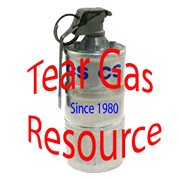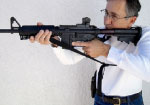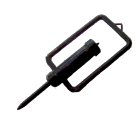Highway Patrol's Improper Disposal Behind Eruption (1997)
Don't let this be you! (click here)
A material can only be a hazardous waste if, it is first: a waste. This can be a technical matter to define but generally a waste is any solid, liquid, or contained gaseous material that you no longer use and either recycle, throw away, or store until you have enough to treat or dispose of. A waste may remain in storage, go out into the dumpster, be poured down a drain, may be sent for re-use or recycling at another location, or...may be set aside for hazardous waste disposal.
EPA considers a waste to be hazardous if it exhibits any of the following characteristics: ignitability, corrosivity, reactivity, or toxicity as defined in 40 CFR 261.21-261.24. Under the Resource Conservation and Recovery Act (RCRA) [40 USC 6901 et seq.], EPA has specifically listed many chemical wastes as hazardous. Although tear gas is not specifically listed as a hazardous waste under RCRA, EPA requires employers to treat waste as hazardous if it exhibits any of the characteristics discussed above.
following characteristics: ignitability, corrosivity, reactivity, or toxicity as defined in 40 CFR 261.21-261.24. Under the Resource Conservation and Recovery Act (RCRA) [40 USC 6901 et seq.], EPA has specifically listed many chemical wastes as hazardous. Although tear gas is not specifically listed as a hazardous waste under RCRA, EPA requires employers to treat waste as hazardous if it exhibits any of the characteristics discussed above.
A law enforcement agency supplied with tear gas munitions will be required to store this material pending use and will at often times be forced to give some thought to the disposal of out-dated or dud munitions. All commercial gas munitions have an expiration date, clearly marked on each round. That date is when that round is no longer guaranteed by the manufacturer to function as designed. That date is usually 3-5 years from the manufactured date. Using outdated munitions on an operation opens your department up to liability if the munitions malfunction and cause injury or unreasonable damage because of the malfunction.
All tear gas munitions are susceptible to adverse storage conditions just like any other ammunition. The manufacturers assemble each round with great care, but in view of the known poor storage facilities available to most police departments, are forced to place an expiration date on their munitions.
If you store the outdated munitions for training they are not waste and do not become hazardous waste until you plan on disposing of them. If the munitions have been properly stored they will more than likely function for years after the expiration date.
All have a much longer shelf life if they are stored under favorable conditions. However, in some areas of the world, such as in the tropics, where heat and humidity are common environmental conditions, the functional life of the munitions is caused to be shortened. There are no other natural factors that are so detrimental to a long shelf life and induce deterioration faster in tear gas munitions than heat and humidity. (See Article on Storage of Munitions)
So, with that said; when tear gas munitions become unserviceable, they must be disposed of for reasons of safety or to prevent it from being mixed in with serviceable rounds.
The act of rendering safe and disposing of munitions can be conservatively described as hazardous. Any individual assigned this duty must be intimately familiar with all his munitions and agents in order to preclude the possibility of an accident or incident during disposal operations. Two officers, equally knowledgeable in munitions design and functioning, should be required to work together. In any case, no one man should ever be allowed to work alone. (Swearingen)
 Out-dated or otherwise unusable pyrotechnic items are considered “hazardous waste" under previously mentioned RCRA (The Resources Conservation and Recovery Act of 1976) and are assigned the EPA Hazardous Waste Code of DOO1 due to their characteristics of being an oxidizer and ignitability. Disposal of these items must be done in accordance with all applicable Federal and/or State laws. These wastes must also be deactivated, before being land disposed.
Out-dated or otherwise unusable pyrotechnic items are considered “hazardous waste" under previously mentioned RCRA (The Resources Conservation and Recovery Act of 1976) and are assigned the EPA Hazardous Waste Code of DOO1 due to their characteristics of being an oxidizer and ignitability. Disposal of these items must be done in accordance with all applicable Federal and/or State laws. These wastes must also be deactivated, before being land disposed.
Many states have hazardous waste management programs, much more stringent than Federal law. Anyone ready to dispose of the product should check with their EPA Regional Office to determine what extent these laws apply.
DO NOT ATTEMPT TO DEFUZE A PROJECTILE/GRENADE, in case it does not ignite. All “duds” should be disarmed by trained and authorized personnel only. In case a projectile jams in the launcher, use caution when you remove the defective round, by facing the launcher down range, wait at least 10 seconds before opening the chamber. Then remove the round from the chamber and place it into a disposal container filled with water. DO NOT TRY TO INVESTIGATE the failure, unless you have been trained to evaluate malfunctioned tear gas projectiles or grenades. (Federal Laboratories)
Chemical Agents should be burned for disposal. Several methods can be employed. The cost, space and area you have available will make one method more acceptable than another. Five methods are:
- Road Flares against the dud fuse. Use long handled shovels to move grenades onto flare. DO NOT use on projectiles.

- Temporary burn pit
- Explosives Unit to deactivate at the same time they explode excess or evidence explosives
- Burn Service your Lab Uses for drugs
- Portable burn chamber
There are some safety measures that should always be employed when disposing of munitions:
- Never Work Alone
- Wear Protective Equipment
- Clear a Safe Work Area
- Monitor Environmental Factors
- Notify Local Agencies
- Police the Disposal Area & Make Sure the Fire (heat) is Out
If you use a Temporary Burn pit click here to see plans.





